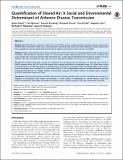| dc.contributor.author | Wood, Robin | en_US |
| dc.contributor.author | Morrow, Carl | en_US |
| dc.contributor.author | Ginsberg, Samuel | en_US |
| dc.contributor.author | Piccoli, Elizabeth | en_US |
| dc.contributor.author | Kalil, Darryl | en_US |
| dc.contributor.author | Sassi, Angelina | en_US |
| dc.contributor.author | Walensky, Rochelle P. | en_US |
| dc.contributor.author | Andrews, Jason R. | en_US |
| dc.date.accessioned | 2014-10-01T14:29:31Z | |
| dc.date.issued | 2014 | en_US |
| dc.identifier.citation | Wood, Robin, Carl Morrow, Samuel Ginsberg, Elizabeth Piccoli, Darryl Kalil, Angelina Sassi, Rochelle P. Walensky, and Jason R. Andrews. 2014. “Quantification of Shared Air: A Social and Environmental Determinant of Airborne Disease Transmission.” PLoS ONE 9 (9): e106622. doi:10.1371/journal.pone.0106622. http://dx.doi.org/10.1371/journal.pone.0106622. | en |
| dc.identifier.issn | 1932-6203 | en |
| dc.identifier.uri | http://nrs.harvard.edu/urn-3:HUL.InstRepos:12987408 | |
| dc.description.abstract | Background: Tuberculosis is endemic in Cape Town, South Africa where a majority of the population become tuberculosis infected before adulthood. While social contact patterns impacting tuberculosis and other respiratory disease spread have been studied, the environmental determinants driving airborne transmission have not been quantified. Methods: Indoor carbon dioxide levels above outdoor levels reflect the balance of exhaled breath by room occupants and ventilation. We developed a portable monitor to continuously sample carbon dioxide levels, which were combined with social contact diary records to estimate daily rebreathed litres. A pilot study established the practicality of monitor use up to 48-hours. We then estimated the daily volumes of air rebreathed by adolescents living in a crowded township. Results: One hundred eight daily records were obtained from 63 adolescents aged between 12- and 20-years. Forty-five lived in wooden shacks and 18 in brick-built homes with a median household of 4 members (range 2–9). Mean daily volume of rebreathed air was 120.6 (standard error: 8.0) litres/day, with location contributions from household (48%), school (44%), visited households (4%), transport (0.5%) and other locations (3.4%). Independent predictors of daily rebreathed volumes included household type (p = 0.002), number of household occupants (p = 0.021), number of sleeping space occupants (p = 0.022) and winter season (p<0.001). Conclusions: We demonstrated the practical measurement of carbon dioxide levels to which individuals are exposed in a sequence of non-steady state indoor environments. A novel metric of rebreathed air volume reflects social and environmental factors associated with airborne infection and can identify locations with high transmission potential. | en |
| dc.language.iso | en_US | en |
| dc.publisher | Public Library of Science | en |
| dc.relation.isversionof | doi:10.1371/journal.pone.0106622 | en |
| dc.relation.hasversion | http://www.ncbi.nlm.nih.gov/pmc/articles/PMC4152288/pdf/ | en |
| dash.license | LAA | en_US |
| dc.subject | Biology and Life Sciences | en |
| dc.subject | Computational Biology | en |
| dc.subject | Population Modeling | en |
| dc.subject | Infectious Disease Modeling | en |
| dc.subject | Plant Science | en |
| dc.subject | Plant Pathology | en |
| dc.subject | Disease Surveillance | en |
| dc.subject | Infectious Disease Surveillance | en |
| dc.subject | Infectious Disease Epidemiology | en |
| dc.subject | Engineering and Technology | en |
| dc.subject | Electronics | en |
| dc.subject | Electronics Engineering | en |
| dc.subject | Equipment | en |
| dc.subject | Measurement Equipment | en |
| dc.subject | Spectrometers | en |
| dc.subject | Spectrophotometers | en |
| dc.subject | Thermocouples | en |
| dc.subject | Transducers | en |
| dc.subject | Measurement | en |
| dc.subject | Time Measurement | en |
| dc.subject | Medicine and Health Sciences | en |
| dc.subject | Epidemiology | en |
| dc.subject | Environmental Epidemiology | en |
| dc.subject | Epidemiological Methods and Statistics | en |
| dc.subject | Social Epidemiology | en |
| dc.subject | Spatial Epidemiology | en |
| dc.subject | Infectious Diseases | en |
| dc.subject | Bacterial Diseases | en |
| dc.subject | Tuberculosis | en |
| dc.subject | Infectious Disease Control | en |
| dc.subject | Public and Occupational Health | en |
| dc.subject | Physical Sciences | en |
| dc.subject | Chemistry | en |
| dc.subject | Chemical Compounds | en |
| dc.subject | Carbon Dioxide | en |
| dc.title | Quantification of Shared Air: A Social and Environmental Determinant of Airborne Disease Transmission | en |
| dc.type | Journal Article | en_US |
| dc.description.version | Version of Record | en |
| dc.relation.journal | PLoS ONE | en |
| dash.depositing.author | Walensky, Rochelle P. | en_US |
| dc.date.available | 2014-10-01T14:29:31Z | |
| dc.identifier.doi | 10.1371/journal.pone.0106622 | * |
| dash.contributor.affiliated | Walensky, Rochelle | |


